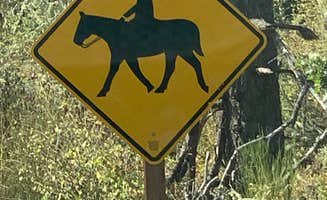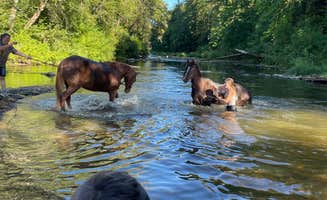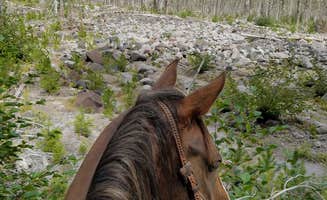Equestrian camping near Vancouver, Washington typically peaks from May through September when trail conditions are optimal for horseback riding. The region receives an annual rainfall of 42 inches, concentrated in the winter months, which creates lush forested terrain and occasional muddy trail sections during spring. Most equestrian campgrounds sit at elevations between 400-1,200 feet, providing varied terrain for trail riding with moderate temperature fluctuations between day and night.
What to Do
Trail riding at Dairy Creek West: L.L. Stub Stewart Memorial State Park offers extensive trail options beyond the primary bridle trails. "The park has many hiking trails of varying length, access to the Banks-Vernonia State Trail, several disc golf courses, cabins, a horse camp, a day use picnic/event area and a hike-in camp area," notes Shane B. The multi-use trail system accommodates riders of all experience levels.
Explore Silver Lake: Seaquest State Park provides access to lakeside trails for scenic riding. "From the visitor center here was an additional path through the marsh with views of Mt. Saint Helen's," explains Ashley B. The park's location makes it ideal for multi-day exploration of the Mount St. Helens area.
Fish while camping: Several parks permit fishing from horseback in designated areas. At Battle Ground Lake State Park, Brian B. describes it as offering "great fishing! Trout, bass, blue gill... swimming area. Store on sites. Nice hike around lake with plenty of spots to rest and fish."
What Campers Like
Secluded equestrian sites: Many riders appreciate the dedicated equestrian camping areas. At Camp Wilkerson, Schona K. notes it's "A great place to camp with the family in tents or an rv, groups, rent a cabin or hold an event like a wedding. Bring your horses and ride the trails and stay at the horse camp."
Self-contained facilities: Horse-friendly campgrounds provide essential equestrian amenities. "The upper bathrooms are amazing and worth the walk near the horse camp," adds Schona K. about Camp Wilkerson, highlighting the facilities specifically designed for equestrian campers.
Trail variety: Riders value diverse terrain options. At Milo McIver State Park, Nancy H. mentions "private feeling hiking trails around the large park," and notes "LOTS of nice, wide horse trails for horse riding enthusiasts" are available for riding adventures.
What You Should Know
Seasonal trail conditions: Winter and early spring can create challenges. Kenny from Beacon Rock State Park advises, "This campground is absolutely gorgeous. Most of the lots are quite private, with a shared trail system in the middle to the restrooms and community spigot." However, trails can become muddy during rainy seasons.
Reservation requirements: Most equestrian sites fill quickly, especially during summer. "Reservations are strongly recommended during summer months when equestrian sites fill quickly," with many parks releasing sites 6-9 months in advance.
Noise considerations: Some campgrounds experience noise from nearby transportation. At Beacon Rock, Becky S. warns "the train runs directly behind the site multiple times an hour and is loud," which may startle some horses unaccustomed to train noise.
Tips for Camping with Families
Playground access: Oxbow Regional Park offers family-friendly amenities near horse trails. Finn M. notes "The recent upgrades to playgrounds are awesome for the kids and the new welcome center makes check in a breeze." These play areas provide entertainment for younger family members.
Educational opportunities: Several parks offer ranger programs for children. At Seaquest State Park, Ashley B. experienced "a great Junior Ranger program with a very enthusiastic park ranger that kept the almost 50 people/kids entertained. She was great at engaging all the kids and teaching them about the park."
Multi-activity sites: Look for campgrounds with diverse recreation options. Battle Ground Lake State Park provides "a cool volcanic lake with a swimming area and great fishing. Its like a mini crater lake," according to Ashley Y., making it perfect for families with varied interests.
Tips from RVers
RV site selection: Choose suitable horse trailer parking locations. At Dairy Creek East, Robert D. explains, "Our spot was very spacious as the length was 45 feet deep on asphalt. It had a picnic table and a fire ring in a well-groomed gravel area about 30' x 30'. The back of our spot was against very high trees."
Water and power considerations: Check hookup locations relative to trailer positioning. "The water and sewer hookups were in the middle of the site, with electric being at the back of the pad. The water pressure was not very good at around 35 psi," notes MickandKarla W. at Dairy Creek West, information that's particularly relevant for horse trailers with living quarters.
Satellite reception: Dense tree cover affects connectivity. Robert D. at Dairy Creek East mentions, "Our spot was on the north side of the road so when we put out our satellite unit it had lots of southern sky to find a signal from," an important consideration for extended stays.





